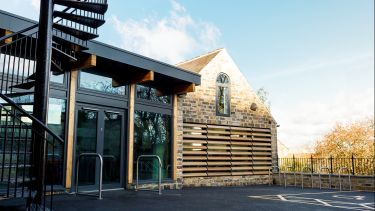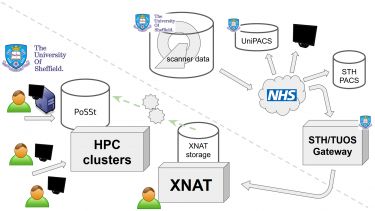POLARIS Image computing lab
The POLARIS research computing infrastructure is used for processing large volume image processing and patient-specific computational modelling based on imaging data.

Image Processing Laboratory
The POLARIS Image Processing Laboratory provides a collaborative working space for image computing researchers, offering desk space for 20 PhD students and postdoctoral researchers in a comfortable and quiet environment in the recently-refurbished POLARIS building. A mixture of Dell Windows/Linux PCs and iMacs are provided, taking advantage of the building’s gigabit connectivity to the University's research computing facilities, as well as links to the Sheffield Teaching Hospitals (STH) NHS Foundation Trust network.
Data Archiving Infrastructure
Data generated by the POLARIS MR scanners is archived in the MRI unit (UniPACS) and STH PACS, and is transferred to the University network for archiving and processing.
- We have developed a bespoke STH/POLARIS gateway in collaboration with the Scientific Computing section of Medical Physics at STH to remove any personally identifiable information before the data is transferred
- The gateway is connected to one of several XNAT servers that POLARIS runs
- POLARIS researchers also have direct access to the PACS data from within the STH network
- Processing of image data can occur after each imaging session is imported into the PoSSt (POLARIS Shared Storage)
Computing Platforms
A wide range of applications are available on the researchers' workstations, leveraging floating licensed software (COMSOL Multiphysics, Medis® Suite MR, Autodesk EAGLE), open source software (itk-snap, 3D Slicer, TigerVNC) and university-wide licenses (MathWorks MATLAB, Ansys/AnsysEDT, GraphPad Prism, IBM SPSS, Adobe Creative Suite).
The most computationally demanding applications are executed on the University High Performance Computing (HPC) clusters (ShARC, iceberg, Bessemer), where POLARIS has full access with different priorities, or on specialist workstations.
Cluster Access
Computation can be carried out in interactive sessions or batch jobs. For interactive sessions with special graphical requirements, the ShaRC and iceberg clusters supply so-called "visualisation nodes" that are equipped with high-spec GPU cards. The solution is based on the VirtualGL project - a combination of specially crafted libraries and a streaming graphical server for the visualisation node; the node can be accessed securely using a TigerVNC client.
Cluster Software includes; Ansys EM / edt, COMSOL Multiphysics, OpenFoam, ANTS, MathWorks MATLAB, Ansys Fluent, Python/conda, Chest Imaging Platform / 3D Slicer, Itk-snap, Offis DICOM toolkit, TD Pulmonary Toolkit
Storage Support
POLARIS has access to:
- 20TB of storage from the University research storage system
- A NetApp server with more than 1PB of storage
Data is split between two physical data centres, and research storage is backed up between the two data centres - this gives better protection against hardware and networking problems.

